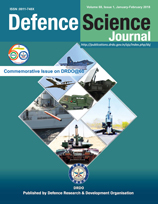A Design of Experiments Methodology for Evaluating Configuration for a Generation Next Main Battle Tank
DOI:
https://doi.org/10.14429/dsj.68.12182Keywords:
Configuration, Evolutionary design, Revolutionary design, Regression, SystemsAbstract
Combat vehicles for generation next main battle tank requires state-of-the-art technologies to counter advanced threats both from conventional and un-conventional sources across various theatres of operation. In addition, they require strategic mobility by road, rail, air and sea. Under such conditions, the trend across the world has been to converge on configurations that are lethal, agile, modular systems and interchangeable mission based turret configurations along with higher survivability which imposes limitations on mobility as mass increases. To achieve all the user objectives as laid down in the qualitative requirements, it is prudent to focus the attention on weight management. The traditional approach of weight management is time consuming, for which an alternate approach using design of experiments is proposed in this paper. To carry out this study, two configurations are selected namely evolutionary and revolutionary design. Keeping the outer boundary as the constraint, a simple linear regression and analysis of variance are carried out with mass and volume data from various systems and sub-systems. Subsequently, the accuracy of the analysis is ascertained using a test of hypothesis using PHStat software. Although this study discusses configuration, the factors responsible for reduced system mass and volume namely technology, materials, intelligence etc have not been discussed. Finally, from the outcome of the study it is observed that the revolutionary design configuration fares better compared to the evolutionary design configuration with a combat mass of only 41 t.
Downloads
Published
How to Cite
Issue
Section
License
 Where otherwise noted, the Articles on this site are licensed under Creative Commons License: CC Attribution-Noncommercial-No Derivative Works 2.5 India
Where otherwise noted, the Articles on this site are licensed under Creative Commons License: CC Attribution-Noncommercial-No Derivative Works 2.5 India


